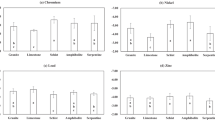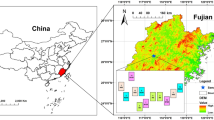Abstract
The effect of zinc on the indigenous nematode fauna of a sandy soil was determined in an experimentally contaminated outdoor field plot. The aims of the study were to describe and quantify the changes in density of separate nematode taxa and total nematodes, and the changes in the number of taxa, species diversity, community maturation, and species composition in response to zinc exposure with time, and to compare the observed responses with benchmark concentrations for soil as derived from the species sensitivity distribution (SSD) for zinc toxicity. Speciation of zinc in pore water was considered and CaCl2-exchangeable zinc concentrations were used as a measure of the bioavailable zinc fraction. After contamination, a reduction of total zinc and an increase of labile sorbed zinc over time occurred, concurrent with various changes in soil and biological characteristics. Data analyses on the nematode species revealed different sensitivity levels for several population and community endpoints to zinc exposure. Based on no observed effect concentration (NOEC) values, the most sensitive community-level response was obtained with principal response curve (PRC) analysis, which incorporates all density data in a single analysis. The PRC-based community NOECs were 56, 100, and 100 mg total Zn/kg dry soil after 3, 10, and 22 months of exposure, respectively. Based on 0.01 M CaCl2-exchangeable zinc, the community response appeared to increase, as NOECs were 4.9, 4.4, and 0.67 mg exchangeable Zn/kg dry weight. Total density was least sensitive, followed by diversity of taxa and the Shannon-Wiener index. NOECs for separate species covered a broad range from sensitive to tolerant species. This range of sensitivities was similar to the one found for other species groups tested in the field plot soil. A comparison was made between benchmark concentrations HC5 and HC50 derived from the general SSD of soil organisms for zinc and the nematode response data. These comparisons roughly confirm the predictions of the SSD model, that is, the community NOEC is in agreement with the benchmark that should protect the soil ecosystem's integrity, and large adverse effects were found at the benchmark derived for setting remediation urgency.
Similar content being viewed by others
Author information
Authors and Affiliations
Additional information
Received: 9 November 2000/Accepted: 2 August 2001
Rights and permissions
About this article
Cite this article
Smit, C., Schouten, A., Van den Brink, P. et al. Effects of Zinc Contamination on a Natural Nematode Community in Outdoor Soil Mesocosms. Arch. Environ. Contam. Toxicol. 42, 205–216 (2002). https://doi.org/10.1007/s00244-001-0029-y
Issue Date:
DOI: https://doi.org/10.1007/s00244-001-0029-y




